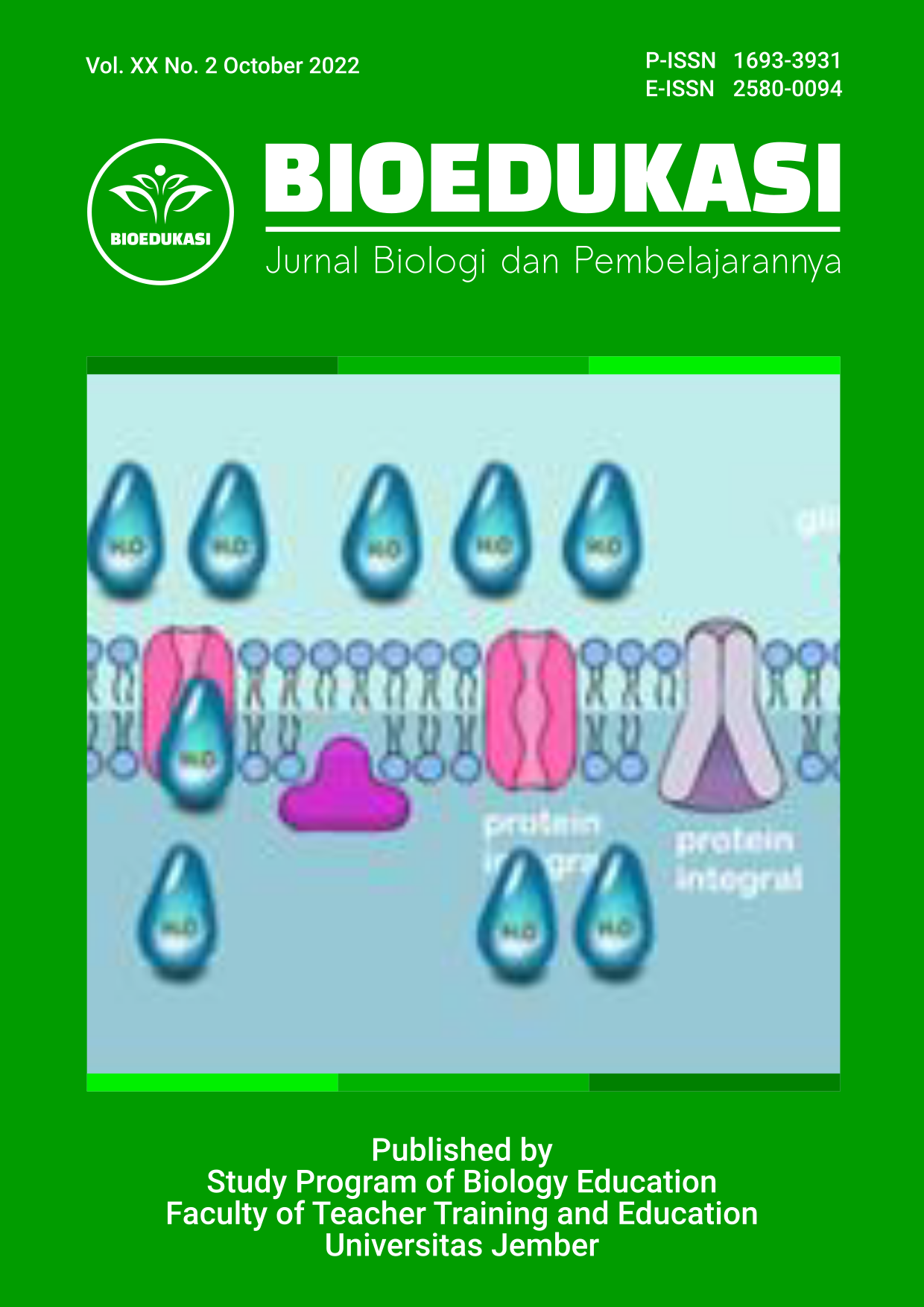Analysis of Citizen Science-Based Flowering Plant Diversity Worksheet Development to Improve Students’ Critical Thinking Ability
DOI:
https://doi.org/10.19184/bioedu.v20i2.34613Keywords:
Biodiversity, Critical Thinking, Citizen Science, WorksheetAbstract
The purpose of this study was to assess the feasibility of the developed Citizen Science-Based Flowering Plant Diversity Worksheet as well as the enhancement of students' critical thinking abilities. This was a pre-experiment with a pretest-posttest design with one group. Validator employed a four-scale validation sheet to assess the feasibility of the Citizen Science-Based Flowering Plant Diversity Worksheet based on competency, practical, knowledge construction, and the appearance of critical thinking ability. Five critical thinking ability indicators were tested: interpretation, analysis, explanation, evaluation, and inference. These indications were tested in 104 10th grade students through a critical thinking ability test before and after studying with the Citizen Science-Based Flowering Plant Diversity worksheet. Descriptive statistics were used to analyze the data. The Citizen Science-Based Flowering Plant Diversity Worksheet was found feasible (95.12%) and students' critical thinking abilities increased moderately (N-Gain = 0.56). The most notable development in critical thinking ability was in interpretation ability, while inference ability improved the least. As a result, the Citizen Science-Based Flowering Plant Diversity Worksheet may be inferred to be quite effective in improving students' critical thinking abilities.
Downloads
References
Aripin, I., & Hidayat, T. (2020). Public perception in Majalengka (Indonesia) toward citizen science concept. Journal of Physics: Conference Series, 1521(4), 1–7. https://doi.org/10.1088/1742-6596/1521/4/042095
Bonney, R; Ballard, H; Jordan, R; McCallie, E; Phillips, T; Shirk, J; Wilderman, C. (2009). Public Participation in Scientific Research: Defining the Field and Assessing Its Potential for Informal Science Education (Issue July).
Bonney, R., Phillips, T. B., Ballard, H. L., & Enck, J. W. (2016). Can citizen science enhance public understanding of science? Public Understanding of Science, 25(1), 2–16. https://doi.org/10.1177/0963662515607406
Facione, P. (1989). Critical Thinking: A Statement of Expert Consensus for Purposes of Educational Assessment and Instruction Leadership Thinking Resources View project Critical Thinking, Decision Making, and Problem Solving View project. ERIC, 1–21. www.insightassessment.com
Facione, P. (2015). Critical Thinking: What It Is and Why It Counts Critical Thinking, Decision Making, and Problem Solving View project INSIGHT Reasoning Skills and Mindset measures for various professional groups View project. https://www.researchgate.net/publication/251303244
Hake, R. R. (1999). Analyzing Change/Gain Scores. http://lists.asu.edu/cgi-bin/wa?A2=ind9903&L=aera-d&P=R6855
Hwang, G.-J., Lai, C.-L., & Wang, S.-Y. (2015). Seamless flipped learning: a mobile technology-enhanced flipped classroom with effective learning strategies. Journal of Computers in Education, 2(4), 449–473. https://doi.org/10.1007/s40692-015-0043-0
Kermish-Allen, R., Peterman, K., & Bevc, C. (2019). The utility of citizen science projects in K-5 schools: measures of community engagement and student impacts. Cultural Studies of Science Education, 14(3), 627–641. https://doi.org/10.1007/s11422-017-9830-4
Langager, P. M. (2019). Implementing a Citizen Science Project in a 9-12 High School Science Classroom. Montana State University. http://dx.doi.org/10.1155/2015/420723%0A
Lindemann-Matthies, P. (2005). “Loveable†mammals and “lifeless†plants: How children’s interest in common local organisms can be enhanced through observation of nature. International Journal of Science Education, 27(6), 655–677. https://doi.org/10.1080/09500690500038116
McKinley, D. C., Miller-Rushing, A. J., Ballard, H. L., Bonney, R., Brown, H., Cook-Patton, S. C., Evans, D. M., French, R. A., Parrish, J. K., Phillips, T. B., Ryan, S. F., Shanley, L. A., Shirk, J. L., Stepenuck, K. F., Weltzin, J. F., Wiggins, A., Boyle, O. D., Briggs, R. D., Chapin, S. F., … Soukup, M. A. (2017). Citizen science can improve conservation science, natural resource management, and environmental protection. Biological Conservation, 208, 15–28. https://doi.org/10.1016/j.biocon.2016.05.015
Peraturan Menteri Pendidikan dan Kebudayaan Indonesia, Pub. L. No. 37 (2018).
Miller-Rushing, A., Primack, R., & Bonney, R. (2012). The history of public participation in ecological research. Frontiers in Ecology and the Environment, 10(6), 285–290. https://doi.org/10.1890/110278
Mrema, E. M. (2021). Convention on Biological Diversity: Opening Statement Ecological Civilization Forum. In Convention of Biological Diversity. www.cbd.int
Novak, J. D., & Gowin, D. B. (1984). Learning How To Learn. Cambridge University Press.
Nugroho, A. A., & Subiyantoro, S. (2017). Pengembangan Modul Sistematika Tumbuhan Tinggi Berbasis Guided Discovery untuk Mengembangkan Kemampuan Berpikir Kritis Mahasiswa Pendidikan Biologi. Bio-Pedagogi: Jurnal Pembelajaran Biologi, 6(2), 19–24.
Rachmawati, N., Supriatno, B., & Anggraeni, S. (2021). Analisis dan Rekonstruksi Lembar Kegiatan Peserta Didik pada Materi Keanekaragaman Hayati. BIODIK: Jurnal Ilmiah Pendidikan Biologi, 7(2), 85–96.
Schneiderhan-Opel, J., & Bogner, F. X. (2020). FutureForest: Promoting Biodiversity Literacy by Implementing Citizen Science in the Classroom. American Biology Teacher, 82(4), 234–240. https://doi.org/10.1525/abt.2020.82.4.234
Silber-Varod, V., Eshet-Alkalai, Y., & Geri, N. (2019). Tracing research trends of 21st-century learning skills. British Journal of Educational Technology, 50(6), 3099–3118. https://doi.org/10.1111/bjet.12753
Zanata, M., & Santovito, G. (2020). the “Da Vinci†Biodiversity Park (Treviso, Italy). a Didactic Garden As Innovative Support To the Teaching of Science in Secondary School. INTED2020 Proceedings, 1(December), 5460–5469. https://doi.org/10.21125/inted.2020.1474




 https://orcid.org/0000-0003-1920-0515
https://orcid.org/0000-0003-1920-0515